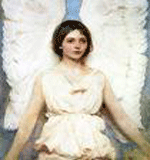Oil painting> List of Painters->Abbot Handerson Thayer
Abbot Handerson Thayer
EARLY DAYS : Abbott
Handerson Thayer(August 12,
1849 –
1921),was an American artist, naturalist and teacher who lived in the late 19th and early 20th centuries. He is best remembered for his work on camouflage and its applications in the military, as well as his paintings of birds and other wildlife. Born in Boston, Massachusetts in 1849, Thayer was the son of a Congregationalist minister. He attended the Massachusetts Institute of Technology, and then studied art at the National Academy of Design in New York City.
Thayer was married twice and had three children. He died in 1921 in New Hampshire. The Thayer School of Art at Dartmouth College, which he founded in 1878, is named in his honor. In addition to his contributions to the world of art and science, Thayer's work has had a lasting impact on the field of camouflage. His book, Concealing Coloration in the Animal Kingdom (1909), introduced the concept of counter-shading, which is now widely used in military camouflage. He also pioneered the use of disruptive patterns in his own paintings of birds and other wildlife. His work has also been an inspiration for contemporary camouflage designers and researchers. |
CAREER :
As a painter of portraits, landscapes, animals and the ideal figure, he won high rank among American artists. Among his best-known pictures are "Virgin Enthroned, Caritas", "In Memoriam", "Robert Louis Stevenson", and "Portrait of a Young Woman"; and he did some decorative work for the Walker Art Building, Bowdoin College, Maine.
 |
Thayer's wife was critically ill when he painted their 12 year old daughter Mary with angel wings in the above painting .Thayer enjoyed painting rapidly,spending no more than three days at a time on a painting for fear of overworking it - though he sometimes choose to return to it later.
Thayer is also well known as a naturalist. He developed
a theory of "protective coloration" in animals, which has attracted
considerable attention among naturalists. According to this theory,
"animals are painted by nature darkest on those parts which
tend to be most lighted by the sky's light, and vice versa";
and the earth-brown of the upper parts, bathed in sky-light,
equals the skylight color of the belly, bathed in earth-yellow
and shadow.
One of Thayer's most controversial theories purported
that "large-scale
protective coloration (or camouflage) had the unique capacity to
bewilder and confuse the mind, especially when present in small
spaces." For this theory, which he was never able to successfully
prove, he drew some criticism among his peers.



